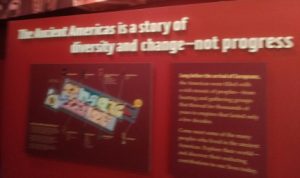Why a (Christian) Liberal Arts Education?
Greatest Thought
James B. Simmons: “What is the greatest thought that has ever occupied your mind?” and, “What is your duty toward fulfilling it?”
This is a rock. How many sides does it have?
- Two? (top/bottom)
- Six? (sort of a rectangular prism)
- Thousands?
- Millions?
This is a sign at the entrance of the “Ancient Americas” exhibit in the Field Museum (Chicago).
- The sign says: “The Ancient Americas is a story of diversity and change — not progress”
- The Field Museum has an emphasis on natural history.
- The “About” section of their website (https://www.fieldmuseum.org/about) ends with these words: “Science is for everyone. And we can’t wait to share it with you.”
- Why would a a “science” museum put an opinion at the entrance of their exhibit?
This chart is from an NPR News article: “Is Sleeping With Your Baby as Dangerous as Doctors Say?”
The author of the article makes the following points:
- some parents choose to sleep with their infants (regardless of recommendations)
- removing the stigma associated with this practice will provide more opportunities for health-care professionals to give guidance for safer bed-sharing practices
- low-risk babies are very low risk … and multiplying a very low risk by 3 (er … 2.8) is still a low risk
Then this chart!?!
| 1 in 46,000 | chance of a low-risk baby dying of SIDS while sleeping in a crib in parent’s room |
| 1 in 16,400 | chance of a low-risk baby dying of SIDS while sleeping in parent’s bed |
| 1 in 13,000 | chance of being hit by lightning in the U.S. in a person’s lifetime |
| 1 in 9,100 | chance of being killed in a car accident in the U.S. in a year |
| 1 in 4,400 | chance of drowning before turning 18 |
| 1 in 1,500 | chance of a high-risk baby dying of SIDS while sleeping in a crib in parent’s room |
| 1 in 150 | chance of a high-risk baby dying of SIDS while sleeping in parent’s bed |
| 1 in 50 | chance of developing a peanut allergy as a child |
- There are quite a few issues I have with this chart and the conclusions that supposedly can be drawn from it:
- Why “chance of lightning strike in lifetime” rather than “chance of death by lightning strike in a year”?
- Why is “peanut allergies” on the list?
- Why is “chance of drowning” spread over 18 years (when SIDS is a one-year risk)?
- If parents in the U.S., encouraged by this article, systematically adopted bed-sharing with infants, it would result in dozens of infant deaths that otherwise would not have occurred!
- Why would a reputable news agency consider this a good article to publish?
This is the same chart with a couple of lines added by me.
| 1 in 1,000,000 | chance of U.S. high school student dying in a school shooting in 2017 (wikipedia) |
| 1 in 79,200 | chance of drowning in a year |
| 1 in 46,000 | chance of a low-risk baby dying of SIDS while sleeping in a crib in parent’s room |
| 1 in 16,400 | chance of a low-risk baby dying of SIDS while sleeping in parent’s bed |
| 1 in 9,100 | chance of being killed in a car accident in the U.S. in a year |
| 1 in 7,100 | chance of U.S. teenager committing suicide in a year (Huffington Post) |
| 1 in 5,000 | chance of dying from drug overdose in a year (drugabuse.org) |
| 1 in 1,500 | chance of a high-risk baby dying of SIDS while sleeping in parent’s room |
| 1 in 150 | chance of a high-risk baby dying of SIDS while sleeping in parent’s bed |
- I removed peanut allergy and lightning strike stats (irrelevant).
- I amortized the drowning statistic to make it per year (rather than over an 18 year period). Reason: SIDS is typically a one-year risk.
- I added (highlighted) other statistics, the first of which reveals a flaw in the logic used by the article’s author.
- The stats regarding suicide and drug overdose are especially striking: Their prevalence is concerning and the fact they are self-induced harm suggests we are facing a “crisis of purpose”.
What do a rock, a sign, and an article about SIDS have to do with a liberal arts education?
- We are bombarded with information, misinformation, and persuasive messaging constantly.
- In these examples we have a “news” organization publishing something that is not news and is harmful to the public health. And we have “science” museum presenting something that is not scientific.
- At times we may agree with those messages and at times the messages may be in our best interest.
- A liberal arts education provides a cognitive framework to parse and dissect this messaging.
- What makes a distinctively Christian liberal arts education valuable is that we have foundation from which to engage a world in the midst of a crisis of purpose.
- So, what’s up with the rock?
- There is a bizarre notion that every “issue” has exactly two sides. If a simple rock has thousands of discernible faces then why would a complex social issue have only two sides?
My Conclusion
- Our society needs educated, thinking, articulate people to counteract the tsunami of false/slanted/persuasive messaging.
- Our society needs the hope and purpose that the Christian faith offers to counteract the crisis of self-inflicted harm.



No comments yet.